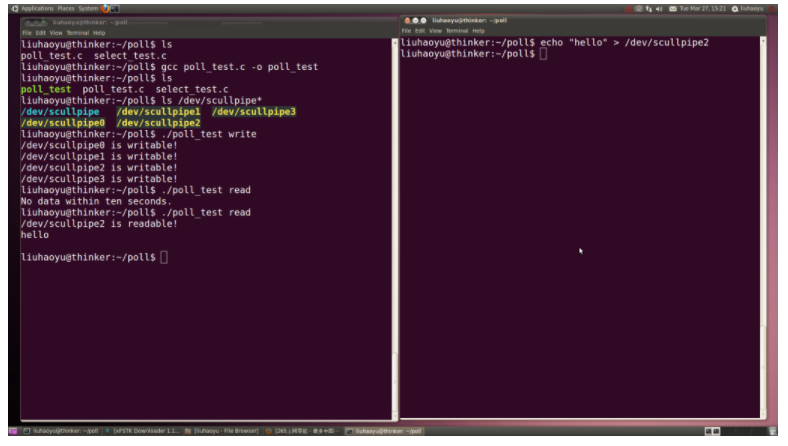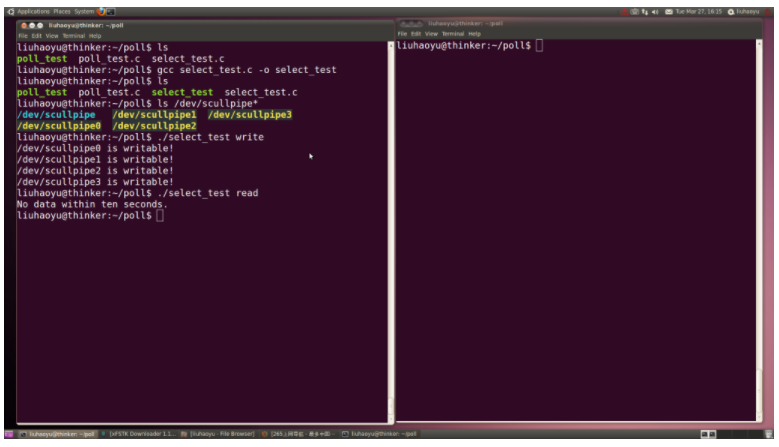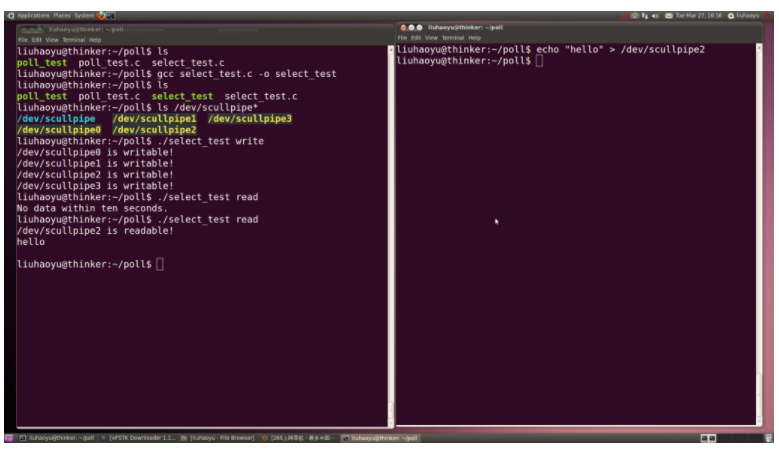编译环境:Ubuntu 10.10
内核版本:2.6.32-38-generic-pae
LDD3源码路径:examples/scull/pipe.c examples/scull/main.c
本文分析LDD3第6章的poll(轮询)操作。要理解驱动程序中poll函数的作用和实现,必须先理解用户空间中poll和select函数的用法。本文与前面的文章介绍的顺序有所不同,首先分析测试程序,以此理解用户空间中的poll和select函数的用法。然后再分析驱动程序怎样对用户空间的poll和select函数提供支持。
一、poll函数的使用
用户态的poll函数用以监测一组文件描述符是否可以执行指定的I/O操作,如果被监测的文件描述符都不能执行指定的I/O操作,则poll函数会阻塞,直到有文件描述符的状态发生变化,可以执行指定的I/O操作才解除阻塞。poll函数还可以指定一个最长阻塞时间,如果时间超时,将直接返回。poll函数的函数原型如下:
int poll(struct pollfd *fds, nfds_t nfds, int timeout);
要监测的文件描述符由第一个参数fds指定,它是一个struct pollfd数组,pollfd结构体定义如下:
struct pollfd { int fd; /* file descriptor */ short events; /* requested events */ short revents; /* returned events */ };
pollfd结构体的第一个成员fd是文件描述符,代表一个打开的文件。第二个成员events是一个输入参数,用于指定poll监测哪些事件(如可读、可写等等)。第三个成员revents是一个输出参数,由内核填充,指示对于文件描述符fd,发生了哪些事件(如可读、可写等等)。
poll函数的第二个参数nfds代表监测的文件描述符的个数,即fds数组的成员个数。
poll函数的第三个参数timeout代表阻塞时间(以毫秒为单位),如果poll要求监测的事件没有发生,则poll会阻塞最多timeout毫秒。如果timeout设置为负数,则poll会一直阻塞,直到监测的事件发生。
poll函数如果返回一个正数,代表内核返回了状态(保存在pollfd.revents中)的文件描述符的个数。如果poll返回0,表明是因为超时而返回的。如果poll返回-1,表明poll调用出错。
poll函数可以监测哪些状态(由pollfd.events指定),以及内核可以返回哪些状态(保存在pollfd.revents中),由下面的宏设定:
POLLIN:There is data to read. POLLOUT:Writing now will not block. POLLPRI:There is urgent data to read (e.g., out-of-band data on TCP socket; pseudo-terminal master in packet mode has seen state change in slave). POLLRDHUP: (since Linux 2.6.17) Stream socket peer closed connection, or shut down writing half of connection. The _GNU_SOURCE feature test macro must be defined in order to obtain this definition. POLLERR:Error condition (output only). POLLHUP:Hang up (output only). POLLNVAL:Invalid request: fd not open (output only). When compiling with _XOPEN_SOURCE defined, one also has the following, which convey no further information beyond the bits listed above: POLLRDNORM:Equivalent to POLLIN. POLLRDBAND:Priority band data can be read (generally unused on Linux). POLLWRNORM:Equivalent to POLLOUT. POLLWRBAND:Priority data may be written.
下面我们看一个测试scullpipe设备的poll操作(内核态poll)的测试程序,该程序使用了我们前面介绍的poll函数(用户态poll)。其代码如下:
#include <stdio.h> #include <stdlib.h> #include <string.h> #include <fcntl.h> #include <unistd.h> #include <linux/poll.h> #include <sys/time.h> #include <sys/types.h> #include <sys/stat.h> int main(int argc, char *argv[]) { int fd0, fd1, fd2, fd3; struct pollfd poll_fd[4]; char buf[100]; int retval; if(argc != 2 || ((strcmp(argv[1], "read") != 0) && (strcmp(argv[1], "write") != 0))) { printf("usage: ./poll_test read|write "); return -1; } fd0 = open("/dev/scullpipe0", O_RDWR); if ( fd0 < 0) { printf("open scullpipe0 error "); return -1; } fd1 = open("/dev/scullpipe1", O_RDWR); if ( fd1 < 0) { printf("open scullpipe1 error "); return -1; } fd2 = open("/dev/scullpipe2", O_RDWR); if ( fd2 < 0) { printf("open scullpipe2 error "); return -1; } fd3 = open("/dev/scullpipe3", O_RDWR); if ( fd3 < 0) { printf("open scullpipe3 error "); return -1; } if(strcmp(argv[1], "read") == 0) { poll_fd[0].fd = fd0; poll_fd[1].fd = fd1; poll_fd[2].fd = fd2; poll_fd[3].fd = fd3; poll_fd[0].events = POLLIN | POLLRDNORM; poll_fd[1].events = POLLIN | POLLRDNORM; poll_fd[2].events = POLLIN | POLLRDNORM; poll_fd[3].events = POLLIN | POLLRDNORM; retval = poll(poll_fd, 4, 10000); } else { poll_fd[0].fd = fd0; poll_fd[1].fd = fd1; poll_fd[2].fd = fd2; poll_fd[3].fd = fd3; poll_fd[0].events = POLLOUT | POLLWRNORM; poll_fd[1].events = POLLOUT | POLLWRNORM; poll_fd[2].events = POLLOUT | POLLWRNORM; poll_fd[3].events = POLLOUT | POLLWRNORM; retval = poll(poll_fd, 4, 10000); } if (retval == -1) { printf("poll error! "); return -1; } else if (retval) { if(strcmp(argv[1], "read") == 0) { if(poll_fd[0].revents & (POLLIN | POLLRDNORM)) { printf("/dev/scullpipe0 is readable! "); memset(buf, 0, 100); read(fd0, buf, 100); printf("%s ", buf); } if(poll_fd[1].revents & (POLLIN | POLLRDNORM)) { printf("/dev/scullpipe1 is readable! "); memset(buf, 0, 100); read(fd1, buf, 100); printf("%s ", buf); } if(poll_fd[2].revents & (POLLIN | POLLRDNORM)) { printf("/dev/scullpipe2 is readable! "); memset(buf, 0, 100); read(fd2, buf, 100); printf("%s ", buf); } if(poll_fd[3].revents & (POLLIN | POLLRDNORM)) { printf("/dev/scullpipe3 is readable! "); memset(buf, 0, 100); read(fd3, buf, 100); printf("%s ", buf); } } else { if(poll_fd[0].revents & (POLLOUT | POLLWRNORM)) { printf("/dev/scullpipe0 is writable! "); } if(poll_fd[1].revents & (POLLOUT | POLLWRNORM)) { printf("/dev/scullpipe1 is writable! "); } if(poll_fd[2].revents & (POLLOUT | POLLWRNORM)) { printf("/dev/scullpipe2 is writable! "); } if(poll_fd[3].revents & (POLLOUT | POLLWRNORM)) { printf("/dev/scullpipe3 is writable! "); } } } else { if(strcmp(argv[1], "read") == 0) { printf("No data within ten seconds. "); } else { printf("Can not write within ten seconds. "); } } return 0; }
测试过程如下图所示:

从上图可以看出,scullpipe0 - scullpipe3都是可写的。但是因为没有向其中写入任何内容,所以读的时候会阻塞住,因为测试程序设置最长阻塞时间为10秒,所以10秒后解除阻塞退出,并打印”No data within ten seconds.”。
下面再次测试读操作,因为设备中没有内容,还是阻塞住,但是在10秒钟内,从另外一个终端向/dev/scullpipe2写入数据,这里是写入字符串”hello”,可以看到,写入数据后,测试程序解除阻塞,并打印”/dev/scullpipe2 is readable!”和”hello”字符串,这个过程如下图所示:

二、select函数的使用
select函数的作用与poll函数类似,也是监测一组文件描述符是否准备好执行指定的I/O操作。如果没有任何一个文件描述符可以完成指定的操作,select函数会阻塞住。select函数可以指定一个最长阻塞时间,如果超时,则直接返回。
select函数的函数原型如下:
int select(int nfds, fd_set *readfds, fd_set *writefds, fd_set *exceptfds, struct timeval *timeout);
select通过三个独立的文件描述符集(fd_set)readfds,writefds,exceptfds指示监测哪些文件描述符,其中readfds中的文件描述符监测是否可进行非阻塞的读操作。writefds数组中的文件描述符监测是否可进行非阻塞的写操作。exceptfds数组中的文件描述符监测是否有异常(exceptions)。
select的第一个参数nfds是三个文件描述符集readfds、writefds、exceptfds中最大文件描述符值加1。
select的最后一个参数timeout代表最长阻塞时间。
select函数返回满足指定I/O要求的文件描述符的个数,如果是超时退出的,select函数返回0。如果出错,select函数返回-1。
有四个宏用来操作文件描述符集:
void FD_ZERO(fd_set *set); 清空一个文件描述符集。 void FD_SET(int fd, fd_set *set); 将一个文件描述符fd加入到指定的文件描述符集set中。 void FD_CLR(int fd, fd_set *set); 将一个文件描述符fd从指定的文件描述符集set中删除。 int FD_ISSET(int fd, fd_set *set); 测试文件描述符fd是否在指定的文件描述符集set中。
下面我们看使用select函数实现的测试驱动中poll操作的测试程序,其代码如下:
#include <stdio.h> #include <stdlib.h> #include <string.h> #include <fcntl.h> #include <unistd.h> #include <sys/time.h> #include <sys/types.h> #include <sys/stat.h> int main(int argc, char *argv[]) { fd_set rfds, wfds; int fd0, fd1, fd2, fd3; char buf[100]; int retval; /* Wait up to ten seconds. */ struct timeval tv; tv.tv_sec = 10; tv.tv_usec = 0; if(argc != 2 || ((strcmp(argv[1], "read") != 0) && (strcmp(argv[1], "write") != 0))) { printf("usage: ./select_test read|write "); return -1; } fd0 = open("/dev/scullpipe0", O_RDWR); if ( fd0 < 0) { printf("open scullpipe0 error "); return -1; } fd1 = open("/dev/scullpipe1", O_RDWR); if ( fd1 < 0) { printf("open scullpipe1 error "); return -1; } fd2 = open("/dev/scullpipe2", O_RDWR); if ( fd2 < 0) { printf("open scullpipe2 error "); return -1; } fd3 = open("/dev/scullpipe3", O_RDWR); if ( fd3 < 0) { printf("open scullpipe3 error "); return -1; } if(strcmp(argv[1], "read") == 0) { FD_ZERO(&rfds); FD_SET(fd0, &rfds); FD_SET(fd1, &rfds); FD_SET(fd2, &rfds); FD_SET(fd3, &rfds); retval = select(fd3 + 1, &rfds, NULL, NULL, &tv); } else { FD_ZERO(&wfds); FD_SET(fd0, &wfds); FD_SET(fd1, &wfds); FD_SET(fd2, &wfds); FD_SET(fd3, &wfds); retval = select(fd3 + 1, NULL, &wfds, NULL, &tv); } if (retval == -1) { printf("select error! "); return -1; } else if (retval) { if(strcmp(argv[1], "read") == 0) { if(FD_ISSET(fd0, &rfds)) { printf("/dev/scullpipe0 is readable! "); memset(buf, 0, 100); read(fd0, buf, 100); printf("%s ", buf); } if(FD_ISSET(fd1, &rfds)) { printf("/dev/scullpipe1 is readable! "); memset(buf, 0, 100); read(fd1, buf, 100); printf("%s ", buf); } if(FD_ISSET(fd2, &rfds)) { printf("/dev/scullpipe2 is readable! "); memset(buf, 0, 100); read(fd2, buf, 100); printf("%s ", buf); } if(FD_ISSET(fd3, &rfds)) { printf("/dev/scullpipe3 is readable! "); memset(buf, 0, 100); read(fd3, buf, 100); printf("%s ", buf); } } else { if(FD_ISSET(fd0, &wfds)) { printf("/dev/scullpipe0 is writable! "); } if(FD_ISSET(fd1, &wfds)) { printf("/dev/scullpipe1 is writable! "); } if(FD_ISSET(fd2, &wfds)) { printf("/dev/scullpipe2 is writable! "); } if(FD_ISSET(fd3, &wfds)) { printf("/dev/scullpipe3 is writable! "); } } } else { if(strcmp(argv[1], "read") == 0) { printf("No data within ten seconds. "); } else { printf("Can not write within ten seconds. "); } } return 0; }
测试过程如下图所示:

从上图可以看出,scullpipe0 - scullpipe3都是可写的。但是因为没有向其中写入任何内容,所以读的时候会阻塞住,因为测试程序设置最长阻塞时间为10秒,所以10秒后解除阻塞退出,并打印”No data within ten seconds.”。
下面再次测试读操作,因为设备中没有内容,还是阻塞住,但是在10秒钟内,从另外一个终端向/dev/scullpipe2写入数据,这里是写入字符串”hello”,可以看到,写入数据后,测试程序解除阻塞,并打印”/dev/scullpipe2 is readable!”和”hello”字符串,这个过程如下图所示:

三、驱动程序中poll操作的实现
用户空间的poll和select函数,最终都会调用驱动程序中的poll函数,其函数原型如下:
unsigned int (*poll) (struct file *filp, poll_table *wait);
poll函数应该实现两个功能:
一是把能标志轮询状态变化的等待队列加入到poll_table中,这通过调用poll_wait函数实现。
二是返回指示能进行的I/O操作的标志位。
poll函数的第二个参数poll_table,是内核中用来实现poll,select系统调用的结构体,对于驱动开发者来说,不必关心其具体内容,可以把poll_table看成是不透明的结构体,只要拿过来使用就可以了。驱动程序通过poll_wait函数,把能够唤醒进程,改变轮询状态的等待队列加入到poll_table中。该函数定义如下:
void poll_wait (struct file *, wait_queue_head_t *, poll_table *);
对于poll函数的第二个功能,返回的标志位与用户空间相对应,最常用的标志位是POLLIN | POLLRDNORM和POLLOUT | POLLWRNORM,分别标志可进行非阻塞的读和写操作。
下面看scullpipe设备对poll操作的实现,其内容其实非常简单:
228static unsigned int scull_p_poll(struct file *filp, poll_table *wait) 229{ 230 struct scull_pipe *dev = filp->private_data; 231 unsigned int mask = 0; 232 233 /* 234 * The buffer is circular; it is considered full 235 * if "wp" is right behind "rp" and empty if the 236 * two are equal. 237 */ 238 down(&dev->sem); 239 poll_wait(filp, &dev->inq, wait); 240 poll_wait(filp, &dev->outq, wait); 241 if (dev->rp != dev->wp) 242 mask |= POLLIN | POLLRDNORM; /* readable */ 243 if (spacefree(dev)) 244 mask |= POLLOUT | POLLWRNORM; /* writable */ 245 up(&dev->sem); 246 return mask; 247}
第239行,调用poll_wait函数将读等待队列加入到poll_table中。
第240行,调用poll_wait函数将写等待队列加入到poll_table中。
241 - 242行,如果有内容可读,设置可读标志位。
243 - 244行,如果有空间可写,设置可写标志位。
246行,将标志位返回。
驱动程序中的poll函数很简单,那么内核是怎么实现poll和select系统调用的呢?当用户空间程序调用poll和select函数时,内核会调用由用户程序指定的全部文件的poll方法,并向它们传递同一个poll_table结构。poll_table结构其实是一个生成”实际数据结构”的函数(名为poll_queue_proc)的封装,这个函数poll_queue_proc,不同的应用场景,内核有不同的实现,这里我们不仔细研究对应的函数。对于poll和select系统调用来说,这个”实际数据结构”是一个包含poll_table_entry结构的内存页链表。这里提到的相关数据结构在linux-2.6.32-38源码中,定义在include/linux/poll.h文件中,代码如下所示:
30/* 31 * structures and helpers for f_op->poll implementations 32 */ 33typedef void (*poll_queue_proc)(struct file *, wait_queue_head_t *, struct poll_table_struct *); 34 35typedef struct poll_table_struct { 36 poll_queue_proc qproc; 37 unsigned long key; 38} poll_table; 39 40static inline void poll_wait(struct file * filp, wait_queue_head_t * wait_address, poll_table *p) 41{ 42 if (p && wait_address) 43 p->qproc(filp, wait_address, p); 44} 45 46static inline void init_poll_funcptr(poll_table *pt, poll_queue_proc qproc) 47{ 48 pt->qproc = qproc; 49 pt->key = ~0UL; /* all events enabled */ 50} 51 52struct poll_table_entry { 53 struct file *filp; 54 unsigned long key; 55 wait_queue_t wait; 56 wait_queue_head_t *wait_address; 57};
poll操作我们就分析完了,内核要求驱动程序做的事并不多,但是我们在学习时,要把poll操作和前面介绍的阻塞型read/write函数以及scullpipe设备的等待队列等结合起来考虑,因为scullpipe设备是一个完整的程序模块。